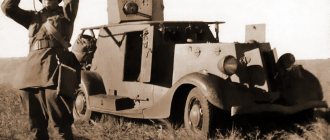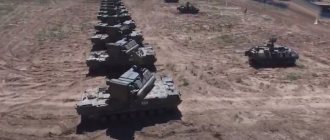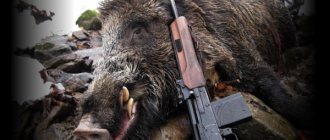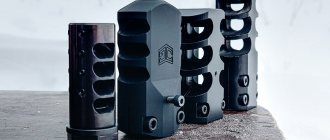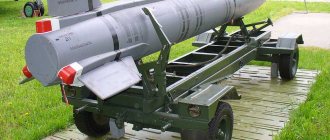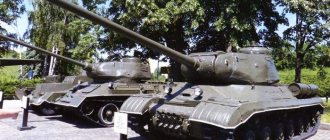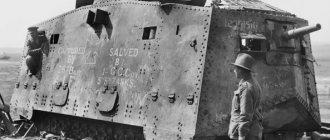Back in 1941, the tanks that were in service with the Red Army easily fought any Wehrmacht armored vehicles. The main enemy of the machines was the confusion of the first months of fighting, which led to large losses of people and equipment. In 1942, the famous heavy Tiger tank entered service with German units. It was no longer possible to fight him on equal terms.
In 1942, projects of Soviet heavy vehicles armed with large-caliber cannons gradually began to appear. One of the most successful tanks was the IS-1, which later became the basis for even heavier tanks.
IS-1 is a heavy Soviet tank from the second half of World War II. The abbreviation "IS" stands for a series of similar machines and stands for "Joseph Stalin".
IS (Joseph Stalin) - Soviet heavy tanks of the Great Patriotic War and post-war development. The first tank of the family had index 1; during the war, this tank was designated IS-1 or IS-85, where the number 85 corresponded to the caliber of the gun mounted on the tank. The most famous and widespread modification of the vehicle was the IS-2 tank, which took part in many battles in the final stage of the war in 1944-1945. After post-war modernizations, the IS-2 tank was in service with the Soviet and then Russian armies until 1995. The last tank of the legendary series was the IS-8, better known as the T-10. Mass-produced, it was one of the last heavy tanks in the world.
History of creation
At the beginning of 1942, a project for further modernization of the KV-1/1s tanks was created in Chelyabinsk, which received the designation KV-13. The design of the vehicle widely used castings made of armored steel, connected by welding. The tank was intended to replace the T-34 and KV series vehicles as part of the concept of a single armored vehicle. But things did not go further than the construction of 3 prototypes.
In the fall of 1942, the first German heavy Tiger tanks appeared near Leningrad, which accelerated the start of work on a new Soviet vehicle with improved protection and armament. In the winter of 1943, a decree was issued on the need to develop and build prototypes of the heavy tank of the IS series, which arrived in Chelyabinsk and at the experimental tank plant No. 100.
The basis for development was the KV-13, and at the same time work was carried out on vehicles armed with 76 and 122 mm cannons (the future IS-1 and IS-2, respectively). By this time, the Soviet military had at its disposal a captured model of the Tiger tank, which was tested by fire from tank and anti-tank guns.
Due to the insufficient effectiveness of 76 mm artillery, it was proposed to create a new 85 mm gun based on the 52-K anti-aircraft gun. At the early stages, the possibility of using the 107 mm ZiS-26 cannon was also considered, but the lack of serial production of ammunition led to the abandonment of the idea in favor of the 85 mm system.
By the summer, two designs were ready, created by TsAKB and Design Bureau of Plant No. 9, which differed in design elements.
When trying to fit the gun into the turret, the designers came to the conclusion that it was necessary to expand the shoulder strap, which entailed a rearrangement of the tank hull. Due to the increase in length, a sixth torsion bar with a roller was introduced into the chassis (which was abandoned when creating the KV-13).
Since the development of the 85 mm system was ahead of the creation of the carrier, production of the KV-85 began in the summer of 1943. The final development of the first tank of the IS series, designated IS-85 (since March 1944 - IS-1), ended only in the fall, and in October the first 2 production vehicles were assembled. By this time, the IS-2 project was being actively finalized in Chelyabinsk, so the life cycle of the IS-1 turned out to be short.
Serial production of the vehicle ceased in January 1944; a total of 107 copies of the tank were assembled. In addition, there was a prototype of the tank, created as part of the work on “Object 248”, armed with a 100 mm S-34 gun.
Heavy tank IS-2.
At the beginning of front-line testing, it became obvious that heavy IS tanks, breaking through enemy defenses, were forced to be distracted by countering enemy tanks, and in this role they had nothing special to boast about. The 85-mm cannon installed in the IS-85 was effective against heavy enemy tanks and Stugas at distances when its own armor could not protect against armor-piercing shells from enemy guns. Heavy self-propelled guns "Ferdinand" could hit the IS-85 from distances prohibitive for its 85-mm gun. The most popular anti-tank missile, the Pak 40, could disable a heavy tank by firing at the turret and sides from a distance of 500-800 meters. The issue of re-equipping the tank with a more effective weapon became acute.
As a result of the Battle of Kursk, it became clear that of the existing guns, only the 122-mm hull gun model 1937 is capable of successfully resisting the “Tiger” at all real combat distances. Anti-aircraft guns, with the same ballistics as 85-mm tank guns, are not effective enough when firing at the Tiger's frontal armor.
In turn, in response to a question about the possibility of installing a 122-mm hull cannon in the turret of an IS tank, the plant management assured that this is possible provided that the gun is equipped with a muzzle brake. The idea of arming the IS tank with a 122 mm gun seemed attractive to the People's Commissar of the Tank Industry. Despite protests from the military regarding the installation of a muzzle brake, Plant No. 9 was ordered to urgently produce a tank version of the A-19 gun and test it no later than November 11, 1944.
The first version of the 122 mm tank gun, with a piston bolt, was ready for testing on November 12, 1943. Tests of the IS-2 tank were hastily carried out. During testing, the gun performed quite satisfactorily. At the beginning of October, the tank passed a mileage test. In a memo addressed to Stalin, it was reported that the IS-2 tank had successfully passed state tests, was well armed, had good maneuverability and armor protection.
At the meeting that took place the next day, opinions on the tank’s armament were divided. Some stood for a 100-mm cannon, as having unitary ammunition, others supported the idea of a hull cannon capable, if necessary, of fighting both enemy artillery and long-term fortification. The result was a decision to adopt the IS-2 heavy tank, armed with a 122-mm cannon. In December of '43, the IS tank went into production at ChKZ. By the end of the year, 67 IS-85 and 35 IS-122 tanks left the plant’s workshops. The last forty IS-85 tanks left the workshop in January 1944. For the IS-2, Plant No. 9 began producing D-25 guns instead of D-5T. The first ten piston-breech guns were manufactured in the late autumn of 1943; a total of one hundred and forty-seven guns were produced.
At the end of the forty-third year, a semi-automatic wedge bolt was developed by plant No. 9 for the D-25 gun. During testing, this weapon proved to be much more convenient, and the rate of fire increased from 1-1.5 to 1.5-2 v/m. In the early spring of 1943, this weapon was put into production. At the same time, the name of the tank was changed from IS-85 to IS-1, as well as IS-122 to IS-2.
Description of design
Layout
The Soviet IS-1 heavy tank, which was an improved and modernized design of the KV-1 heavy tank, was configured classically. At the same time, the armored hull from bow to stern was successively divided into a control compartment, a fighting compartment and an engine-transmission compartment. The crew of the tank consisted of 4 people.
The driver was located in the control compartment on the longitudinal axis of the tank, three members of the tank crew (commander, gunner and loader) were located in the fighting compartment, which extended to part of the armored hull and turret. The D-5T gun was also installed here, along with its ammunition and part of the fuel tanks. The transmission, engine and liquid cooling radiators were located in the rear of the tank.
Armor protection of the hull and turret
The armor protection of the Soviet IS-1 heavy tank was developed according to a differentiated anti-ballistic principle. At the same time, it protected the tank crew and its main units from damage by medium-caliber shells in the main projectile-dangerous directions, as well as from medium and large fragments. The armored body, with the exception of the frontal parts, was welded from rolled armor plates with a thickness of 90, 75, 60, 30 and 20 millimeters, which were connected to each other and the frame. The frontal part of the IS-1 hull was streamlined in shape and had rational angles of inclination of the armor to the vertical. It was produced by casting.
Its thickness in different places ranged from 30 to 120 millimeters. It was connected to other hull parts and armor plates by welding. The turret of the IS-1 heavy tank also had a complex, streamlined shape. The sides of the turret had an armor thickness of up to 100 millimeters and were oriented with an inclination to the vertical normal, which increased projectile resistance. The front (frontal) part of the turret with a rectangular embrasure for mounting a gun was formed at the intersection of four hemispheres. This part was produced by casting and bolted to the rest of the parts that formed the tower. The armor mantlet of the gun had the shape of a cylindrical segment made of rolled and curved armor plate.
It had three holes of different shapes and sizes for installing a gun, a coaxial machine gun and an optical sight. The turret was mounted on a shoulder strap, which had a diameter of 1800 millimeters in the roof of the fighting compartment and was secured with hook-shaped grips, which prevented the turret from being torn off or falling off when the tank overturned or rolled heavily on board. Offset to the left from the longitudinal axis of the tank, a commander's cupola was mounted on its main turret for the commander to view the area with armor thickness of the vertical walls up to 85 millimeters. To get into and out of the tank, the crew used two main round hatches: one double-leaf in the commander's cupola and the second single-leaf above the loader's location.
The driver did not have his own hatch, which reduced his chances of survival if the car was hit. There was a bottom hatch at the bottom of the hull, which could be used for emergency evacuation of the crew.
Armament
The main armament of the IS-1 heavy tank was the 85-mm D-5T rifled tank gun, developed in 1943 on the basis of the 52-K anti-aircraft gun. It was installed on axles in the tower and was completely balanced. The D-5T gun had vertical aiming angles ranging from −5° to +25°. The trigger when firing was electric, but it was also possible to fire a shot with a manual trigger. The tank's ammunition load for the gun was 56 rounds of unitary loading. The ammunition for the D-5T cannon was located on the sides of the fighting compartment. Three DT machine guns with a caliber of 7.62 millimeters were used as auxiliary weapons for the IS-1 heavy tank.
One of them was installed to the right of the driver’s seat in the hull and was rigidly fixed, being the directional one, the second was mounted in the armored mantlet and mated with the gun, and the third was installed in the tide of the rear part of the turret in a ball mount. The ammunition for all three DT machine guns consisted of 2520 rounds of ammunition, which were loaded into discs. In later periods of the tank's production, the front-mounted machine gun was abandoned, since firing from it was ineffective, and its presence significantly reduced the armor resistance of the hull. In addition, the tank crew was armed with personal weapons, which consisted of TT pistols and a PPS submachine gun, as well as F-1 grenades in quantities of 8 to 16 pieces.
Chassis, engine and transmission
The IS-1 heavy tank was equipped as a power plant with a four-stroke V-shaped twelve-cylinder liquid-cooled V-2-IS diesel engine, which could develop a maximum power of 520 horsepower, which ensured that the tank developed maximum speed when driving on flat terrain or highways up to 37 kilometers per hour.
When starting the engine, an inertia starter with a manual or electric drive was used. The IS-1 heavy tank had three fuel tanks, which were located in the fighting compartment (two) and in the engine compartment (one). The tank could also, if necessary, be equipped with four additional external tanks with a total capacity of 360 liters, which were not connected to the common fuel system of the power plant.
The IS-1 heavy tank was equipped with a mechanical transmission, which consisted of:
- main (main) multi-disc clutch, operating on the principle of dry friction of steel against ferrodo;
- gearbox (four-speed), equipped with a range multiplier (with 8 forward gears and 2 reverse gears);
- two two-stage onboard planetary rotation mechanisms equipped with a multi-disc optimized locking friction, which worked on the principle of dry friction steel on steel;
- band brakes;
- two double-row combined final drives.
The drives for controlling the transmission by the tank driver were mechanical. According to its type, the suspension of the IS-1 heavy tank was individual torsion bar, working for each of the 6 solid cast gable support rollers of small diameter (550 millimeters) for each side. For each support roller, a travel limiter for the suspension balancers was welded to the armored body.
The upper sleeve of each track was supported by three small solid cast rollers on each side. The rear drive wheels were equipped with removable gear rims with a lantern type of engagement. The sloths had a shape identical to the shape of the road wheels and were located in front. The screw-type track tensioning mechanism was located at the drive wheel on both sides. Each of the two tracks was assembled from 86 tracks, which had a single-ridge shape and a width of 650 millimeters.
See also[edit]
- Tank portal
- KV-1 heavy tank
- T-10 heavy tank
- ISU-152 assault gun
- ISU-122 assault gun
- List of Soviet tanks
- March of Soviet tankers
Tanks of comparable role, performance and era[edit]
- German heavy tank Tiger I - comparable to IS-1 / IS-85
- German heavy tank Tiger II - comparable to the IS-2 of the 1944 model and the IS-3
- American medium tank M26 Pershing - comparable to the IS-2 model 1944.
- British Centurion heavy cruiser tank -comparable to IS-1/IS-2
- British heavy tank Conqueror, developed after World War II - comparable to IS-3 / IS-4
- French prototype of the AMX 50 heavy tank - comparable to the IS-2 model 1944 and IS-3 / IS-4
Technical characteristics of IS-1
| Combat weight, t | 44 |
| Travel speed, km/h | 40 |
| Armament | 1x85mm D5-T85, 3x7.62 mm DT |
| Cruising range, km | 150 |
| Crew, people | 4 |
| State | accepted into service in 1943 |
| Developer | KB ChKZ |
| Manufacturer | CHKZ |
| Production | small series 1943 |
| Length, mm | – with gun forward – 8560 – hull – 6770 |
| Width, mm | 3070 |
| Tower roof height, mm | 2735 |
| Ground clearance, mm | 465 |
| Wed. beat ground pressure, kg/cm2 | 0.78 |
| Obstacles to be overcome | – rise, deg. – 36 – ford, m – 1.3 |
| engine's type | diesel V-2-10 (V-2-IS) |
| Maximum power, hp | 520 |
| Fuel capacity, l | 500+360 |
| Specific power, hp/t | 11,8 |
| Maximum speed, km/h | 40 |
| Cruising range, km | 150 |
| Reservation, mm | – hull forehead – 120 – turret forehead – 100 |
| Means of setting smoke curtain | 2 dsh |
| Aim | 10T-15, PT-4-15 |
| Radio station | 10-RK-26 |
Operators[edit]
China
- People's Liberation Army: 60 IS-2s delivered in 1950–1951. Used during the Korean War and in concrete bunkers on the Sino-Soviet border.
Cuba
- Cuban Army: 41 IS-2M delivered in 1960.
Czechoslovakia
- Czechoslovak Army: 8 IS-2/IS-2M in service 1945-1960. The two IS-3s, delivered in 1949, were used only for testing and military parades.
East Germany
- NVA: 60 IS-2s delivered in 1956. Operated until 1963.
Egypt
- Egyptian Army: 100 IS-3Ms operated from 1956 to 1967, some used in the 1967 Six-Day War.
Nazi Germany
- Wehrmacht: Captured one or two IS-2s in May 1945 [22]
Hungary
- Hungarian People's Army: 68 IS-2s in service from 1950 to 1956. After the suppression of the Hungarian Revolution in 1956, all were returned to the Soviet Union. [23]
Israel
- IDF: Three IS-3Ms captured in Egypt in 1967. Reused as indirect artillery pieces on the Bar Lev line in Sinai and as fortifications for fixed tower bunkers along the Jordan Valley border.
North Korea
- Korean People's Army: small number of IS-2s; never saw combat in the Korean War.
Poland
- Polish Ground Forces: Approximately 71 IS-2s were used in combat from 1944 to 1945. 180 IS-2s survived as of 1955 and remained in service until the 1960s; some were later converted into armored recovery vehicles. Two IS-3s were purchased in 1946 for testing purposes only.
Romania
- Romanian Ground Forces: One IS-2 captured during clashes on the Romanian border from 28 May to 7 June 1944. The tank was subsequently displayed in Bucharest. [24]
South Ossetia
- South Ossetian Army: Operated several IS-2, IS-3 and T-10 until 1995.
Soviet Union
- Red Army: Heavy breakthrough tank 1944-1945.
- Soviet Army: Withdrew from service in the early 1970s.
Novorossiysk rebels
- One IS-3, previously displayed on a pedestal in the village of Aleksandro-Kalinovo near Konstantinovka as a monument to the Great Patriotic War, was used by the Armed Forces of Novorossiya in combat during the 2014 pro-Russian unrest in Ukraine. [25] Konstantinovka was retaken by Ukrainian forces on July 7, 2014, along with the IS-3. [26] [27]
Combat use
Is-1 tanks entered service with breakthrough regiments at the end of winter 1944, displacing the aging KV-1/1s. The crews included 2 officers and 2 sergeants, training was conducted at a training ground in the Tula region.
The first battle of the IS-1 was carried out in February, leading an offensive on the Fastov-Belaya Tserkov line.
German tanks, allowing Soviet vehicles to close range, opened fire, destroying several IS-1s. Three weeks later, several IS-1s were destroyed by 88 mm anti-aircraft guns during the battles near Uman.
In early to mid-March, battles between IS-1 and Tigers were recorded, which burned several IS-1 vehicles. At the same time, the return fire of Soviet tanks turned out to be ineffective due to the long combat distance (according to various estimates from 1.5 to 1.8 km). In the first ten days of the month, two tanks burned down as a result of fire from 75 mm Wehrmacht assault guns. These clashes once again confirmed the weakness of the IS-1 weapons and accelerated the saturation of the army with IS-2 vehicles.
The surviving IS-1s were used in various sectors of the front until the end of the war, and then were transferred to the category of training vehicles. Some vehicles took part in the assault on Berlin. The official date for removing the vehicle from service is May 1954.
Modernization of IS-2.
The very first collisions with German tanks revealed the insufficient strength of the front armor of the hull. To eliminate this drawback of the IS-2, at the beginning of forty-four, the body began to be hardened to a higher hardness. And they achieved the opposite of what they wanted. The armor turned out to be fragile and prone to the formation of a large number of secondary fragments. How can we explain the significant losses of heavy tanks during the winter and spring of this year?
In February 1944, TsNII-48 received an order to carry out work, the purpose of which was to strengthen the armor of the IS-2 hull. Studies have shown that the existing shape of the nose assembly will be able to withstand armor-piercing shells of 75 and 88 mm caliber only if the armor thickness is increased to 145-150 mm.
Therefore, the best solution was to change both the shape of the IS-2 nose assembly and the hardening modes. This hull option is better known as a “straight nose” hull. The front sheet lost its hatch-plug, and the sheet itself was installed at an angle of sixty degrees to the vertical. This innovation made it possible to eliminate the penetration of the front plate of the IS-2 at firing angles of plus or minus thirty degrees by an 88-mm German PTA almost point-blank.
They decided not to touch the lower frontal sheet, which was much less durable. Giving an angle greater than the existing angle of thirty degrees required major changes to the design of the IS-2 tank. To increase durability, track laying was placed between the tow hooks. And the probability of damage to the lower frontal sheet is quite low.
There were two types of IS-2 tank hulls with a straight nose:
- with a welded bow assembly from Uralmashplant, produced since May of forty-four;
- with a cast nose assembly, factory No. 200, produced in June 1944.
However, Plant No. 200 produced both types of hulls in parallel for some time.
It was not possible to significantly improve the armor protection of the IS-2 turret. The turret, designed to accommodate an 85 mm gun, is statically balanced. The same tower, after installing a 122-mm cannon, received a moment of imbalance of a thousand kilograms per meter. The terms of reference provided for strengthening the tower's protection to 130mm, which had to be abandoned due to the need for a radical change in the design.
A trace in history and gambling addiction
The IS-1, which was essentially small-scale, became a test vehicle that made it possible to create the IS-2 tanks, which were noticeably superior to German technology in terms of armament power. The weak armor protection of the frontal projections, already noted on the IS-1, passed on to the successor, which only received a modernized casting of the nose section in mid-1944.
IS-1 tanks are gaming vehicles in the computer simulators World of Tanks, War Thunder and a number of others.
The only manufacturer of the IS-1 model in 1:35 scale is the Dragon company. At the same time, the replica quality of the set is far from ideal - replacement of elements of the chassis and turret is required, as well as the use of photo-etched parts that improve the perception of the model.
Surviving cars[edit]
There are several surviving IS series tanks, examples of which can be found at the following address:
IS-2
- OS. Górali [standing tank], Krakow, Poland
- Polish Army Museum, Warsaw, Poland
- Weapons Museum at Fort Winiary, Poznan, Poland
- Museum of Armored Weapons at the Land Forces Training Center, Poznan, Poland (active, see film)
- People's Liberation Army Tank Museum, Beijing, China.
- Freedom Park, Overloon, The Netherlands.
- Museum of the History of Ukraine in World War II, Ukraine
- Kurzeme Fortress Museum, Zante, Latvia.
- Diorama of the Battle of Kursk, Belgorod, Russia.
- American Heritage Museum, Greater Boston, USA
- Army Technical Museum, Lešany, Czech Republic [28] (formerly in Prague as a monument to Soviet tank crews)
IS-2M
- Imperial War Museum Duxford, England.
- Cuban Tank Museum, Russia.
- Victory Park (Park Pobedy - Victory Park), Ulyanovsk, Russia.
- Victory Park on Poklonnaya Hill, Moscow, Russia.
IS-3
- IDF Armored Corps Museum, Israel.
- Museum of Armored Weapons, Army Training Center, Poznan, Poland
- Army Technical Museum, Lešany, Czech Republic (active). [28]
- Polish Army Museum, Warsaw, Poland. (Fort Chernyakov, branch of the museum).
- National Museum of Armor and Cavalry, Fort Benning, Georgia, USA.
- Victory Park in the northern part of Ulyanovsk, Russia.
- Ulyanovsk SVU, Ulyanovsk, Russia
- Museum of Military Glory, Gomel, Belarus.
- Diorama of the Battle of Kursk, Belgorod, Russia.
- At least one IS-3 was used by the separatist government in the Donbass before being captured by Ukrainian forces.
IS-3M
- Egyptian National War Museum, Cairo Citadel, Egypt.
- Military Vehicle Foundation, California, USA. [29]
- Royal Museum of the Armed Forces and Military History, Brussels, Belgium. (still working)
IS-4
- Cuban Tank Museum, Russia.
IS-7
- Cuban Tank Museum, Russia.
Gallery[edit]
- IS-2
- IS-2M
- IS-2M in the Kubinkovsky Tank Museum
- IS-3 at the Leshany Military Technical Museum
- Heavy tank IS-3 in the Museum of Polish Military Equipment in Warsaw.
- Former Egyptian Army IS-3M
Sources [edit]
- Baryatinsky, Mikhail (2006). ISIS tanks
. Hersham, Surrey: Ian Allan Publishing. ISBN 0711031622; (13) 9780711031623 - Glantz, David M.; House, Jonathan M. (2015). When the titans collided.
How the Red Army Stopped Hitler (revised and expanded (Kindle) ed.). University Press of Kansas. ISBN 978-0-7006-2152-1. - Jentz, Thomas (1995). German Panther tank: in search of combat superiority
. Atglen, PA: Schiffer Publishing. ISBN 0-88740-812-5 - Jentz, Tom; Doyle, Hillary (1993). Heavy tank Tiger-1 1942–45
. illustrated by Sarson, Peter. Osprey. ISBN 978-1-85532-337-7. - Perrett, Brian (1987). Soviet armor since 1945. London: Blandford Press. ISBN 0-7137-1735-1.
- Sewell, Stephen "Cookie" (2002). “A red star is a white elephant?” in Armor
, July–August 2002, pp. 26–32. Fort Knox, KY: US Army Weapons Center. ISSN 0004-2420 - Zaloga, Stephen (1994). Heavy tank IS-2 1944-1973
. Osprey Publishing. ISBN 978-1-85532-396-4. - Zaloga, Stephen (1996). Heavy tanks KV-1 and 2 1939–1945
. Osprey Publishing. ISBN 978-1-8553-2496-1. - Zaloga, Stephen; Grandsen, James (1984). Soviet tanks and military equipment from World War II
. London: Arms and Armor Press. ISBN 0-85368-606-8.

